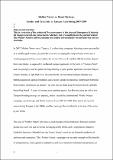Files in this item
Mother Nature as brand strategy. Gender and creativity in Tampax advertising 2007-2009
Item metadata
| dc.contributor.author | Rostvik, Camilla Mork | |
| dc.date.accessioned | 2020-02-06T15:30:04Z | |
| dc.date.available | 2020-02-06T15:30:04Z | |
| dc.date.issued | 2020-02-05 | |
| dc.identifier | 257732600 | |
| dc.identifier | 5bf09349-74ac-4124-8f22-55fd9d9e8198 | |
| dc.identifier | 000546312400006 | |
| dc.identifier | 85088469952 | |
| dc.identifier.citation | Rostvik , C M 2020 , ' Mother Nature as brand strategy. Gender and creativity in Tampax advertising 2007-2009 ' , Enterprise & Society , vol. First View . https://doi.org/10.1017/eso.2019.36 | en |
| dc.identifier.issn | 1467-2227 | |
| dc.identifier.other | ORCID: /0000-0001-9916-917X/work/68647925 | |
| dc.identifier.uri | https://hdl.handle.net/10023/19419 | |
| dc.description.abstract | In 2007, Mother Nature saved Tampax. An advertising campaign, featuring nature personified as a middle-aged woman, played a decisive role in helping the tampon brand overcome a challenging period. Five years earlier, the owners, Procter & Gamble (P&G) had developed their own plastic, as opposed to cardboard, tampon applicator in the form of Tampax Pearl, and were promptly sued for patent infringement by the original plastic applicator inventor Playtex (Hanes Brands), a fight P&G lost. On other fronts, the menstrual product industry was battling against an aging population and menstruation-suppressing hormonal birth control, resulting in an annual 1 percent market share drop for the previously globally best-selling brand. A team of women at the Leo Burnett advertising agency came up with a new Tampax branding strategy in response, and as a result the international Mother Nature campaign ran in Europe and North America from 2007 till 2009. This article surveys the issues facing Tampax in the 2000s, and the campaign that stabilized it at the top of the sector by the 2010s. | |
| dc.format.extent | 40 | |
| dc.format.extent | 467181 | |
| dc.language.iso | eng | |
| dc.relation.ispartof | Enterprise & Society | en |
| dc.subject | HF Commerce | en |
| dc.subject | N Visual arts (General) For photography, see TR | en |
| dc.subject | NDAS | en |
| dc.subject.lcc | HF | en |
| dc.subject.lcc | N1 | en |
| dc.title | Mother Nature as brand strategy. Gender and creativity in Tampax advertising 2007-2009 | en |
| dc.type | Journal article | en |
| dc.contributor.sponsor | The Leverhulme Trust | en |
| dc.contributor.institution | University of St Andrews. School of Art History | en |
| dc.contributor.institution | University of St Andrews. Centre for Contemporary Art | en |
| dc.identifier.doi | 10.1017/eso.2019.36 | |
| dc.description.status | Peer reviewed | en |
| dc.identifier.grantnumber | ECF-2017-036 | en |
This item appears in the following Collection(s)
Items in the St Andrews Research Repository are protected by copyright, with all rights reserved, unless otherwise indicated.

